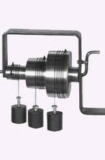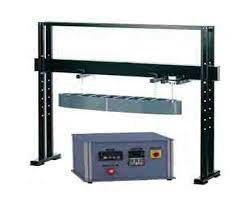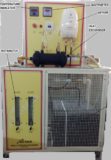Ship Vibrations Apparatus Model MT 144
Home » Products » Ship Vibrations Apparatus Model MT 144
Ship Vibrations Apparatus Model MT 144
Sci-tech Ships Vibrations Apparatus Model MT 144 is designed to enable students to investigate a simple hull model for resonance phenomena. It may be used with the Flotation Tank or the model is simply suspended in air. The unit is used to investigate the dynamic behavior of a ship structure. It therefore allows the first steps in the area of experimental vibration analysis or modal analysis. Many of the principal phenomena associated with ship resonant vibration are clearly demonstrated. At a more advanced level the distribution of mass and second moment of area may be calculated and using a Young’s Modulus value for the material of the ship shaped beam, the natural frequencies may be estimated by a simple tabular method or other means and compared with the measured value. Experimental vibration analysis is an indispensable element of modern shipbuilding development activity. This trainer allows the natural frequencies and modes of the model ship to be measured and recorded. The simple ship form simplifies the mathematical resolution of the problem. The model ship and an electrodynamics exciter are attached to a height adjustable cross beam. The beam has a high natural frequency that doesn’t interfere with the measurements. A function generator creates different exciter signals: sinusoidal, triangular and rectangular signals. The frequency, amplitude and offset are adjustable. An acceleration sensor at various points measures the response of the model to the vibrations generated. For experiments in water, a tank is supplied with the apparatus.
| Size: | 98cm x 40cm x 85cm (LxWxH) |
| Weight: | 15 kg |
Item Description
Features
- dynamic behaviour of a ship structure
- simple ship form simplifies the mathematical approach
- different excitation signals possible
- optional excitation and measuring points
Sci-tech Ships Vibrations Apparatus Model MT 144 is designed to enable students to investigate a simple hull model for resonance phenomena. It may be used with the Flotation Tank or the model is simply suspended in air. The unit is used to investigate the dynamic behavior of a ship structure. It therefore allows the first steps in the area of experimental vibration analysis or modal analysis. Many of the principal phenomena associated with ship resonant vibration are clearly demonstrated. At a more advanced level the distribution of mass and second moment of area may be calculated and using a Young’s Modulus value for the material of the ship shaped beam, the natural frequencies may be estimated by a simple tabular method or other means and compared with the measured value. Experimental vibration analysis is an indispensable element of modern shipbuilding development activity. This trainer allows the natural frequencies and modes of the model ship to be measured and recorded. The simple ship form simplifies the mathematical resolution of the problem. The model ship and an electrodynamics exciter are attached to a height adjustable cross beam. The beam has a high natural frequency that doesn’t interfere with the measurements. A function generator creates different exciter signals: sinusoidal, triangular and rectangular signals. The frequency, amplitude and offset are adjustable. An acceleration sensor at various points measures the response of the model to the vibrations generated. For experiments in water, a tank is supplied with the apparatus
Nowadays, experiment-based vibration analysis is an essential component in shipbuilding design and development.
The MT 144 unit helps students take their first steps in the field of experimental vibration analysis or modal analysis of structures. Using this trainer, the dynamic behaviour of a ship structure is studied, teaching students the fundamentals of experimental vibration analysis.
The MT 144 unit can be used to measure and record the natural frequencies and modes of a model ship. The simple, idealised ship shape makes it easier to approach the problem mathematically. The plastic model ship has nine ribs and an elliptical line plan.
The model ship is attached to a rigid cross-member by springs. The enclosed box cross-section with high rigidity means the natural frequency of the cross-member is negligibly high.
An electrodynamic vibration exciter causes the model ship to vibrate. A function generator produces the excitation signal, which can be adjusted in amplitude and frequency. An arbitrarily positionable acceleration sensor measures the model’s response to the excitation signal. In this manner, the transfer functions for various points of the model ship can be generated step by step. These can be used to determine the vibration modes for various natural frequencies. Experiments can also be conducted in water.
An additional tank is required to conduct these experiments (not included). Complementary experiments can be conducted with additional ballast and weights.
See also different:

Sci-tech Linear & Angular Speed Apparatus Model MT 093 stepped shaft is secured to a main shaft, which itself is secured within a bracket. The bracket can be bench or wall mounted. Wrapped around the circumference of each step of the shaft [...]



